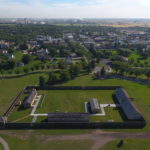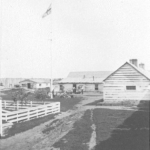The Fort Heritage Precinct, located on the banks of the North Saskatchewan River, features a re-creation of a North-West Mounted Police (NWMP) Fort built in the spring of 1875 by 20 dedicated men of the NWMP’s ‘A’ Division, a historical village, and the 1937 Warden’s Residence from the former Provincial Gaol.
In November 1874, ‘A’ Division completed a gruelling 1,170 mile march from Fort Dufferin, Manitoba to Fort Edmonton. Led by Inspector William Dummer Jarvis, the men wintered in Edmonton before settling 20 miles downstream the following spring at what is now modern-day Fort Saskatchewan. The new Sturgeon Creek Post, quickly renamed Fort-on-the-Saskatchewan, brought a national police presence to the area.
North-West Resistance
In 1885, rumours that Indigenous war parties might attack Fort Saskatchewan and Edmonton stoked fears among settlers. In response, the federal government dispatched 39 members of the 65th Battalion, Mount Royal Rifles, to Fort Saskatchewan to provide security. The fort’s commanding officer, Inspector Henry Arthur Griesbach, deputized 35 local men to supplement his force of 20 and allowed 84 women and children to shelter inside the fort.
The fort’s palisade walls were rebuilt and strengthened to provide better protection and accommodate the enlarged force and citizens. The fort was divided in two with women and children taking refuge in the northern half, and the Mounties, soldiers, and deputies residing in the southern half. Four new bastions were built to give sentries a clear site line down each wall and long sharpened poles were erected at an angle inside the walls.
Although the rumours of attack never came to fruition, and the 65th Mount Royal Rifles left Fort Saskatchewan by July, the Indigenous people’s resistance alarmed colonists enough to call for a larger police presence in the area. As a result, Fort Saskatchewan became headquarters for the 100-member “G” Division until they were moved to Edmonton in 1913. A Provincial Gaol was erected on the Fort’s former site in 1915 and torn down in 1994.

